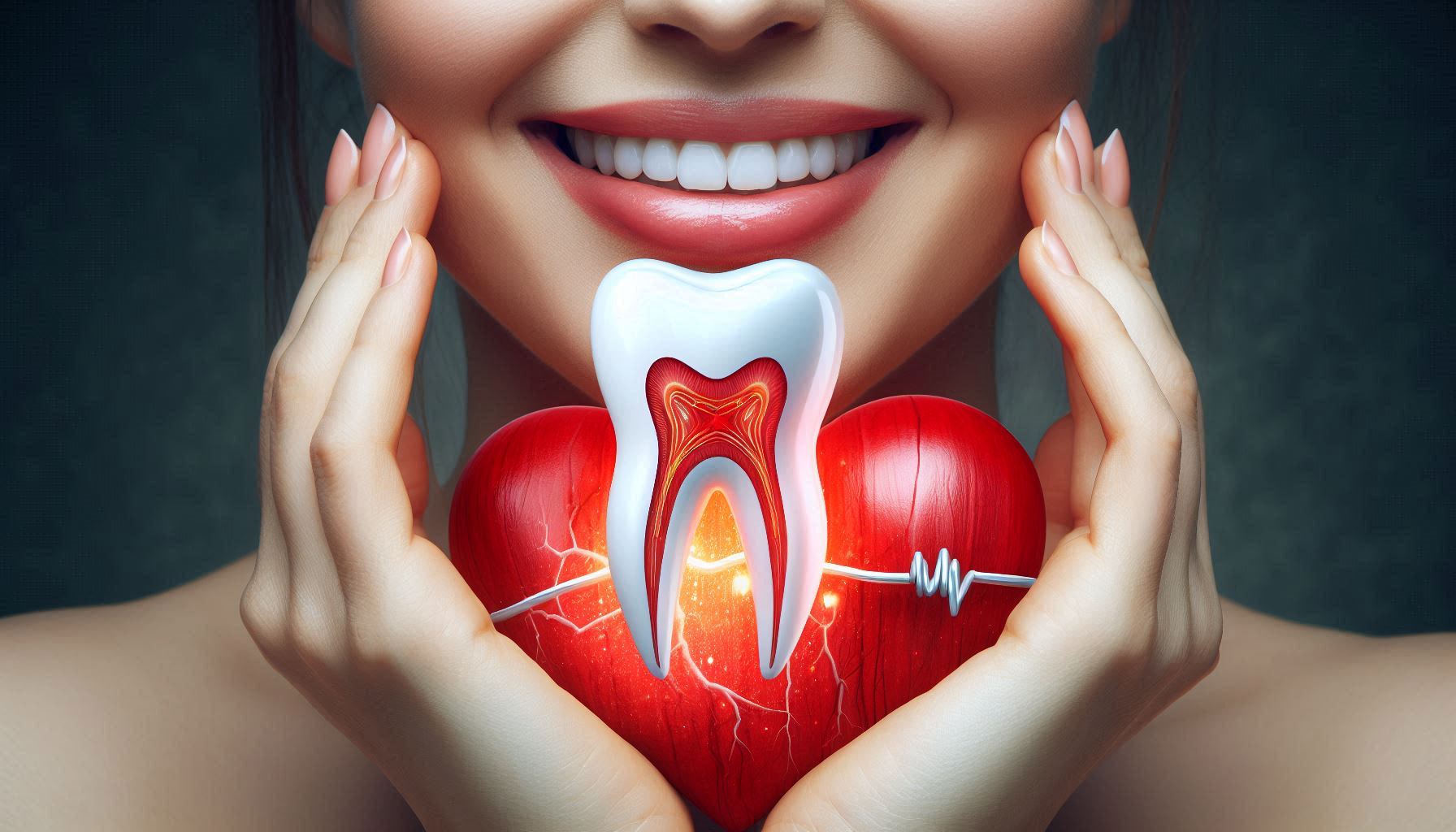In recent years, healthcare experts have uncovered a concerning connection between poor oral health and cardiovascular disease (CVD). While it may seem that oral health and heart disease are unrelated, emerging scientific research indicates that the condition of your teeth and gums could offer vital clues about your heart health. This newfound link is prompting doctors and researchers to reassess how they approach both prevention and diagnosis in healthcare. At the heart of this connection is the role of gum disease, or periodontal disease, which has been shown to contribute to the development of heart disease. Chronic inflammation from gum infections can trigger systemic inflammation, a key factor in the buildup of plaque in the arteries, a condition known as atherosclerosis. Infected gums can also allow harmful bacteria to enter the bloodstream, where they may contribute to the formation of blood clots and increase the risk of heart attack or stroke.
This growing body of evidence underscores the importance of integrating oral care into broader health strategies, particularly for individuals at risk for cardiovascular disease. Maintaining good oral hygiene through regular brushing, flossing, and professional dental check-ups is essential, not only for preventing gum disease but also for safeguarding heart health. As healthcare professionals increasingly recognize the connection between oral health and cardiovascular disease, they are beginning to adopt a more holistic approach to patient care. By focusing on both oral hygiene and heart health, we can take proactive steps to reduce the risk of serious cardiovascular problems. This integrated approach encourages prevention and early detection, ultimately leading to better outcomes for overall health and well-being.
The Rise of Oral Health-CVD Research: Setting the Stage
While it’s long been known that a lack of proper oral hygiene can lead to cavities, gum disease, and tooth loss, it’s only in the last few decades that the scientific community has begun to explore how these conditions might be connected to more serious systemic diseases, particularly cardiovascular disease. Cardiovascular disease is the leading cause of death worldwide, affecting millions of people each year. At the same time, poor oral health, particularly conditions like periodontal disease, is also widespread, affecting approximately 50% of the global population to varying degrees.
For years, the idea that poor oral health could be a risk factor for heart disease was largely speculative. However, in the 1990s, early studies started to emerge that hinted at a potential relationship. As research into both areas continued to evolve, experts began to realize that there were common mechanisms at play—especially chronic inflammation, bacterial infections, and immune responses—that could explain why individuals with periodontal disease were more likely to suffer from heart disease.
Today, hundreds of studies have shown that poor oral health is indeed a significant risk factor for heart disease, with some suggesting that gum disease could even be as dangerous as smoking in terms of its impact on cardiovascular health.
The Science Behind the Connection: Gum Disease and Heart Health
To fully understand the link between oral health and heart disease, it’s important to examine the biological and physiological processes that underlie both conditions. The connection is far more than a simple correlation; it’s based on several shared mechanisms that interact in complex ways.
1. The Role of Inflammation
At the heart of both periodontal disease and cardiovascular disease is inflammation. Inflammation is a natural immune response to infection or injury, and while it plays a crucial role in defending the body, chronic or excessive inflammation can be harmful.
In the case of periodontal disease, the gums become inflamed due to bacterial infections. This condition is caused by the accumulation of plaque and tartar on the teeth, which harbors bacteria that irritate the gum tissue. As the immune system tries to fight off the infection, the gums become red, swollen, and bleed easily. In severe cases, this inflammation can destroy the gum tissue and the bone structure that supports the teeth.
Interestingly, the inflammation in the gums doesn’t stay localized. Bacteria from the infected gums can enter the bloodstream through tiny tears in the tissue, where they can travel throughout the body. Once in the bloodstream, these bacteria stimulate the production of inflammatory molecules, such as cytokines and C-reactive protein (CRP), that can damage blood vessels and trigger the formation of arterial plaque. Over time, this inflammation can contribute to the development of atherosclerosis, a condition in which the arteries become hardened and narrowed due to the accumulation of plaque, cholesterol, and other substances.
In fact, studies have shown that individuals with periodontal disease have higher levels of CRP—an inflammatory marker associated with an increased risk of heart attack and stroke. The presence of these inflammatory molecules can make blood vessels less flexible, which increases blood pressure and makes the heart work harder. In turn, this process raises the risk of heart attacks, strokes, and other cardiovascular events.
2. Bacterial Translocation and its Impact on the Heart
Another important factor linking gum disease and heart disease is bacterial translocation—the process by which harmful bacteria from the mouth enter the bloodstream and travel to distant organs, including the heart.
The mouth is home to millions of bacteria, both good and bad, which form a complex ecosystem known as the oral microbiome. Under normal circumstances, the body’s immune system can keep these bacteria in check. However, when gum disease occurs, the bacteria proliferate and can enter the bloodstream, particularly when the gums are inflamed or bleeding. Once in the bloodstream, these bacteria can travel to the heart and other organs, potentially leading to infections and inflammation in the cardiovascular system.
Certain types of bacteria associated with gum disease, such as Porphyromonas gingivalis and Fusobacterium nucleatum, have been specifically linked to atherosclerosis. These bacteria are capable of adhering to the walls of blood vessels, where they can initiate the formation of plaque and contribute to the narrowing and hardening of arteries. Over time, this process can increase the risk of heart attack and stroke.
Shared Risk Factors: Smoking, Diabetes, and More
While the biological mechanisms outlined above provide some explanation for the connection between oral health and heart health, it’s important to note that there are also several shared risk factors that contribute to both conditions. These include:
1. Smoking
Smoking is one of the most well-established risk factors for both gum disease and cardiovascular disease. The harmful chemicals in tobacco smoke damage the gums and tissues in the mouth, making them more susceptible to bacterial infection. Smoking also reduces blood flow to the gums, which impairs the body’s ability to fight off infections and heal tissue damage. In the cardiovascular system, smoking causes the blood vessels to constrict, increases blood pressure, and contributes to the buildup of plaque in the arteries, all of which raise the risk of heart disease.
2. Diabetes
Diabetes is another common risk factor for both gum disease and cardiovascular disease. People with diabetes are more prone to infections, including gum disease, due to high blood sugar levels, which weaken the immune system and make it harder for the body to fight off bacteria. Furthermore, high blood sugar levels can also contribute to the development of atherosclerosis by damaging blood vessels and increasing the risk of plaque buildup.
Diabetes and cardiovascular disease share many of the same underlying mechanisms, such as inflammation, endothelial dysfunction (damage to the lining of blood vessels), and insulin resistance. As a result, individuals with poorly controlled diabetes are at higher risk for both gum disease and heart disease.
3. Obesity
Obesity is a significant risk factor for both conditions. Excess body weight increases the level of inflammation in the body, which can exacerbate gum disease and contribute to the development of cardiovascular disease. Additionally, obesity is closely linked to other risk factors for heart disease, such as high cholesterol, high blood pressure, and insulin resistance. These factors can contribute to the hardening of the arteries and increase the likelihood of heart attacks and strokes.
Impact on Women, the Elderly, and Other Groups
While poor oral health and cardiovascular disease can affect anyone, certain groups of people may be at higher risk due to specific biological, social, and environmental factors.
1. Women and Heart Disease
Women may experience unique risks when it comes to oral health and cardiovascular disease. Hormonal fluctuations during pregnancy, menstruation, and menopause can influence the health of the gums. For example, pregnancy-related gum disease, known as pregnancy gingivitis, is common and can increase a woman’s risk of heart disease. Additionally, women with conditions like polycystic ovary syndrome (PCOS), which affects hormone levels, may be more prone to both gum disease and cardiovascular problems.
2. Elderly Populations
As people age, they often face an increased risk of both periodontal disease and cardiovascular issues. The elderly may have more difficulty maintaining proper oral hygiene due to physical limitations or cognitive decline, making them more susceptible to gum disease. Additionally, age-related changes in the cardiovascular system, such as stiffening of the arteries, can increase the risk of heart disease. For elderly individuals, maintaining oral health may be a critical component of overall cardiovascular health.
Preventive Strategies: Protecting Your Teeth, Protecting Your Heart
Understanding the connection between oral health and cardiovascular disease offers an opportunity to take preventive measures that can protect both your teeth and your heart. The following strategies are key to reducing the risk of both gum disease and heart disease:
1. Maintaining a Healthy Diet
Eating a balanced diet rich in fruits, vegetables, whole grains, and lean proteins can help support both oral and heart health. Foods that are rich in antioxidants, omega-3 fatty acids, and fiber can reduce inflammation in the body and help protect against both gum disease and cardiovascular disease. Conversely, reducing the intake of sugar, processed foods, and trans fats is essential for keeping both gums and arteries healthy.
2. Practicing Proper Oral Hygiene
Brushing your teeth at least twice a day, flossing daily, and using mouthwash can help prevent the development of gum disease and keep bacteria under control. Regular dental check-ups are crucial for identifying early signs of gum disease and ensuring prompt treatment.
3. Quit Smoking
Stopping smoking is one of the most important steps you can take to protect both your oral and cardiovascular health. Smoking not only contributes to gum disease but also increases the risk of heart disease by damaging blood vessels and promoting plaque buildup.
4. Managing Stress and Exercise
Physical activity is a powerful tool for reducing inflammation in the body and improving both oral and heart health. Exercise helps regulate blood pressure, improve circulation, and reduce stress, all of which benefit both the gums and the cardiovascular system. Managing stress through relaxation techniques like meditation, yoga, and deep breathing can also help lower the risk of both gum disease and heart disease.
5. Regular Medical and Dental Check-ups
Maintaining both regular dental and medical appointments is essential for early detection of potential problems. If you have risk factors for cardiovascular disease, such as hypertension or diabetes, your doctor can work with you to manage these conditions and reduce the risk of both heart disease and gum disease.
Conclusion
The connection between oral health and heart disease is multifaceted and increasingly supported by scientific research. Recognizing that the condition of your gums and teeth can offer valuable insights into your cardiovascular health is crucial for achieving overall well-being. By adopting a proactive approach that prioritizes both oral and heart health, individuals can significantly reduce their risk of developing these conditions and enjoy a longer, healthier life.
Oral health plays a vital role in heart disease prevention, with gum disease acting as a potential risk factor for cardiovascular issues. Inflammation from periodontal disease can contribute to the development of atherosclerosis and other heart conditions. Additionally, poor oral hygiene and neglected dental care increase the likelihood of bacterial infections entering the bloodstream, which may harm blood vessels and heighten heart disease risk. Therefore, maintaining good oral health is not only essential for a radiant smile but also for a healthy heart.
To safeguard both your oral and cardiovascular health, it is important to integrate daily oral hygiene practices, such as brushing and flossing, into your routine. Regular dental and medical check-ups help identify early signs of gum disease or cardiovascular problems, ensuring timely intervention. Additionally, a balanced diet rich in nutrients, combined with lifestyle modifications like quitting smoking, managing stress, and engaging in regular physical activity, can further reduce your risk for both gum disease and heart disease. By focusing on prevention and taking care of both your teeth and heart, you can positively influence your overall health, preventing complications and enhancing your quality of life. Investing in your oral hygiene today will help protect your smile and your heart for years to come.
SOURCES
American Heart Association. 2012. Oral health and cardiovascular disease: A review of the literature and future directions. Circulation, 125(23), 2755–2764.
Beck, J. D., Eke, P. I., Jin, L., & Krause, A. 2013. Periodontal disease and cardiovascular disease: Epidemiology and potential mechanisms. Periodontology 2000, 62(1), 1-18.
Dominguez, A., Baldassarre, D., Berloco, P., Schaefer, O., & Pascucci, V. 2018. Periodontal health and cardiovascular disease: Insights from the scientific literature. European Heart Journal, 39(4), 303-312.
Khan, N., Azhar, M., Sultan, F., & Baig, M. 2015. The relationship between periodontal disease and cardiovascular disease: A review. Journal of Clinical Periodontology, 42(12), 1020-1029.
Lockhart, P. B., Bolger, A. F., Gilbert, T. L., Marschall, S. S., O’Donnell, M. P., & Varon, J. 2012. Periodontal disease and atherosclerotic vascular disease: Does the evidence support an independent association?. Circulation, 125(13), 1397-1407.
Pussinen, P. J., Sorsa, T., Väänänen, H., & Koskinen, K. 2015. Oral health, inflammatory markers, and cardiovascular disease: The link between chronic periodontitis and heart disease. Current Opinion in Lipidology, 26(6), 456-462.
Sanz, M., Köhler, T., Sanz, J., & D’Aiuto, F. 2018. Role of periodontal infection in systemic health: An overview of current research. Journal of Clinical Periodontology, 45(9), 877-888.
Tonetti, M. S., Jepsen, S., Jervøe-Storm, P. M., & Harris, H. R. 2020. Periodontal therapy and cardiovascular disease: A systematic review and meta-analysis of randomized controlled trials. Journal of Periodontal Research, 55(5), 569-579.
Van Dyke, T. E., Kornman, K. S., & Pihlstrom, B. L. 2019. Linking periodontal disease with cardiovascular disease: A review of the literature. Journal of Periodontology, 90(4), 459-466.
Zhang, H., Qiu, Z., Li, Y., Yang, C., & Ma, Z. 2016. Oral pathogens and atherosclerosis: Evidence for an inflammatory link. Atherosclerosis, 252, 167-174.
HISTORY
Current Version
January 15, 2025
Written By:
SUMMIYAH MAHMOOD




